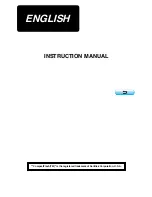
BNP
®
55 SUCTION BLAST CABINET
Page 6
© 2019 CLEMCO INDUSTRIES CORP.
www.clemcoindustries.com
Manual No. 23350, Rev G, 02/19
1.9.8 Bicarbonate of soda:
Bicarbonate of soda is
not recommended for use in standard cabinets. Bicarb is
a one-use media, which will quickly saturate the filter
cartridge(s). Best performance from bicarb media is
achieved with pressure blasting, requiring a pressure
vessel. Refer to Clemco’s AEROLYTE cabinet line for
cabinets that are specifically designed for use with
bicarbonate of soda.
1.10
Compressed-Air Requirements
1.10.1
The size of the compressor required to operate
the cabinet depends on the size of the air jet and
blasting pressure. Unless otherwise specified, cabinets
are supplied with a No. 5 (5/32" orifice) jet. Refer to the
table in Figure 4 to determine cfm requirements. Consult
with a compressor supplier for suggested compressor
size based on the air consumption.
NOTE: A separate
air line is required for the reverse-pulse dust
collector. If preferred, remove the plug from the
auxiliary air port (shown in Figure 4) and connect a
1/4″ ID or larger air line to the dust-collector pulse
reservoir. Refer to the dust-collector owner’s manual
for setup instructions.
Compressed-Air Consumption in CFM
BNP Gun
Jet
Orifice
Nozzle
Orifice
CFM
PSI
No. 4
1/8"
5/16"
21
80
No. 5
5/32"
5/16"
32
80
No. 6
3/16"
3/8"
47
80
*No. 7
7/32"
7/16"
62
80
*No. 8
1/4"
1/2"
86
80
* Using this combination could affect usable media
size; refer to Section 1.9.
Figure 4
1.10.2
The air filter at the air-inlet connection reduces
condensed water from the compressed air. Its use is
especially important in areas of high humidity or when
using fine-mesh media. Moisture causes media to clump
and inhibits free flow through the feed assembly. If the
filter does not remove enough moisture to keep media
dry and flowing, it may be necessary to install an air
dryer or aftercooler in the air-supply line.
1.11
Electrical Requirements
Standard 300 cfm and 600 cfm cabinets and dust
collectors are 120-volt single phase. Incoming power to
the cabinet is supplied by a U-ground plug; plug it into a
120-volt outlet.
All wiring external of the cabinet is provided by the user
to comply with local electrical codes.
1.11.1
Electrical requirements depend on the size and
phase of the dust-collector exhauster motor. NOTE: Full
load amps (FLA) shown below are for the motor only;
the lights draw less than 1 amp. Standard cabinets are
supplied as follows:
300 cfm: 1/2 HP, 120/208/240 V, 1-PH, 60 HZ,
wired 120, FLA 20/7, 208/3.4, 240/3.5.
600 cfm: 1 HP, 120/240 V, 1-PH, 60 HZ,
wired 120, FLA 120/12, 208/6.6, 240/6.2.
Refer to Section 2.5 to connect electrical service
2.0
INSTALLATION
Unless noted otherwise, the sequence of assembly in
Sections 2.2 through 2.7 may be done in any order that
is convenient for the installer.
2.1
General Installation Notes
2.1.1
Refer to Figure 1 (and Figure 2 for optional
RPC-2 Dust Collector) for the general arrangement.
Place all components in a convenient location where
compressed air and electrical service are available. The
cabinet location must comply with OSHA and local
safety codes. Allow for full access to all doors and
service areas, and for efficient handling of large parts.
Provide enough clearance at the dust collector to do
maintenance and to remove the dust container.
Determine the best location for all components and
position them before making compressed air
connections, electrical connections, and attaching flex
hose.
2.1.2
Refer to the dust-collector owner’s manual to
set up the dust collector and prepare it for operation.
2.2
Connect Conveying (flex) Hose
2.2.1
Connect the smaller-diameter flex hose
between the cabinet-hopper pipe adaptor and reclaimer
inlet adaptor, and connect the larger-diameter hose
between the reclaimer outlet and dust-collector inlet. It is
easier to slip the hose over the adaptors and create a
tighter seal if the first two or three inches of wire are
removed from the inside of the hose. Use care not to
damage the hose. Clamp flex hose securely in position
with worm clamps provided.
NOTE: The hose wire
helps dissipate static electricity in the conveying
hose and helps ground each segment. In order for
the hose wire to dissipate static electricity, the wire
must touch the metal of each segment.








































